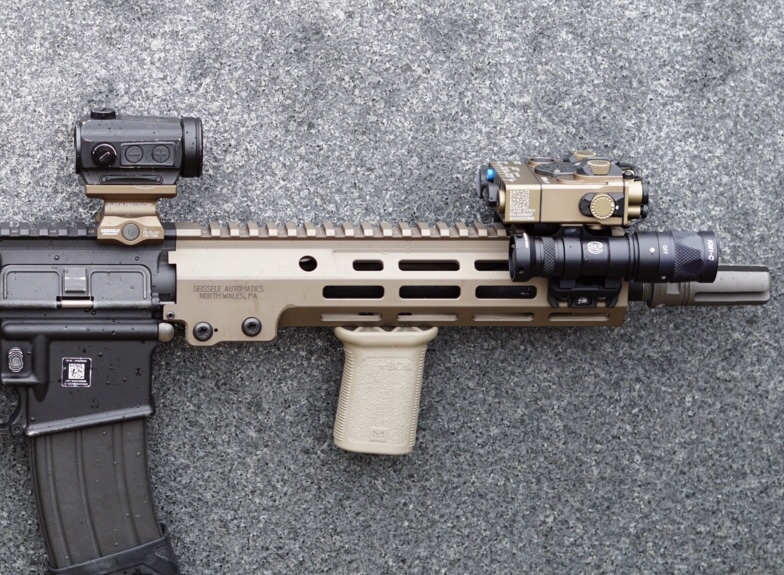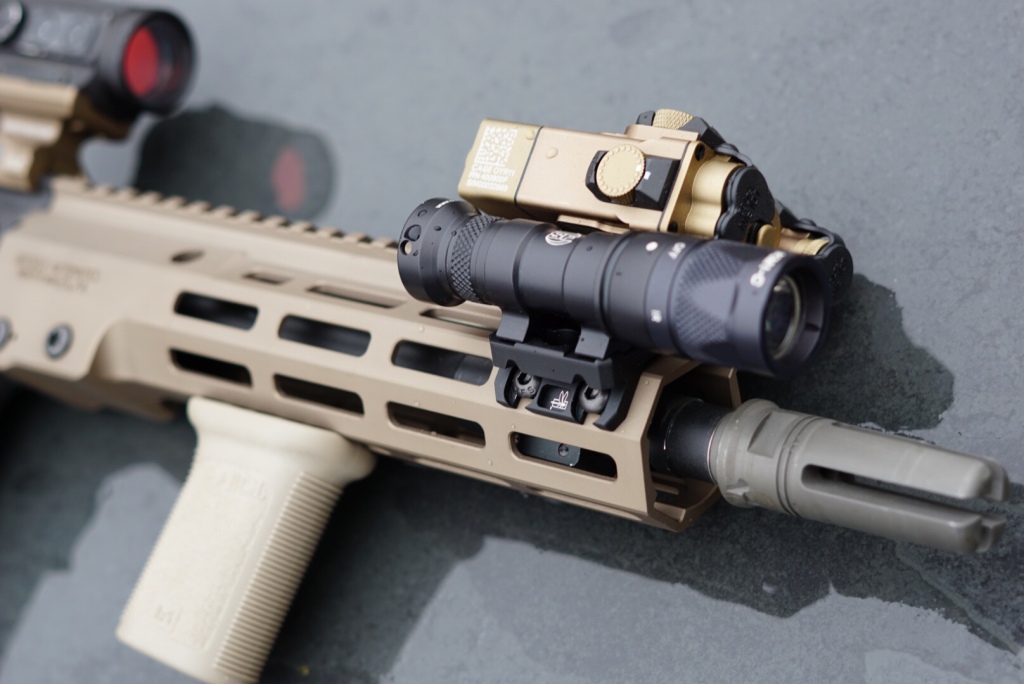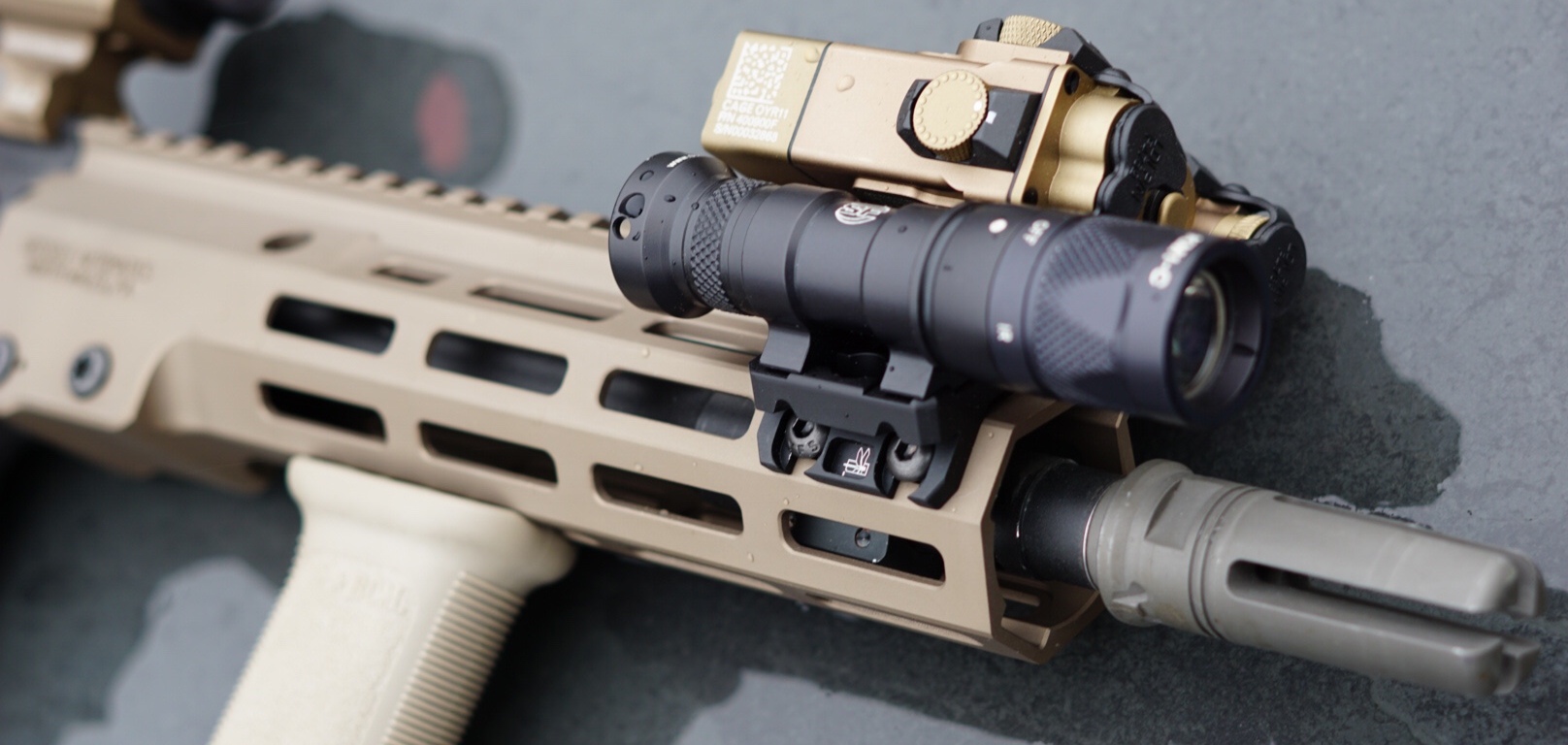The Block 3 URG-I 9.3” rail, well… That’s actually not what it’s called at all. This particular example would simply be known as the 9.3” Super Modular Rail Mk16 by it’s original manufacturer, Geissele. HAO have taken a somewhat sensible step of simply calling it the 9.3” Mk16.
Firstly, the URG-I refers to the complete package, which would comprise of the 13.5” rail but only when used in conjunction with a whole host of other parts to create the full Upper Receiver Group – Improved.

And the whole “Block” terminology? Nothing more than a dumbing down by people on the internet to explain its place in the development of the M4, certainly until it gets rolled out to “Big Army” and isn’t confined to just USASOC, it won’t receive any formal block designation.
The other thing to consider is that at time of writing this blog, the 9.3” has yet to be seen in the hands of anyone except private purchasers. The 13.5” is starting to be seen more and more, with a number being used within USASOC overseas. There’s even a couple of pics floating around of the incredibly rare 10.5” Mk16, but the 9.3” is still considered a civilian only rail at present. In fact, it was one such civilian build that inspired this entire overhaul of my Tokyo Marui MWS.

I’ve covered the 13.5” rail in an earlier review (read it here), and I’d suggest that no matter which of the two you’re considering, reading both might give you a clear picture.

So what’s different between this particular rail and it’s well endowed 13.5” brother? would you be surprised if I said very little at all? The only noticeable difference in the rails dimensions are in its total length, where the 13.5” has seven M-LOK slots running down its length, the 9.3” has a more modest four slots on each of its seven planes.

The other minor difference is in the minor lack of an NSN stamp (as you’d expect from a civilian accessory), although the same Geissele Automatics, North Wales, PA trades remain on the right hand side.
It’s important to note that despite these two rails being virtually identical, HAO made the difficult decision to not release a rail based upon pictures alone. Only after getting hands on with a genuine 9.3” Mk16 did they start their manufacturing process.

This is in direct contrast to at least one other reproduction Mk16 rail manufacturer, who simply guesstimated all of their measurements by back engineered photos and released a rail that on first impressions looks alright, but suffers from stupid little errors that actually affect its functionality (more on that later)
The next item on the agenda is colour, or “color” for you traitorous tea-hating colonials. The tanodizing process used to create the DDC (Desert Dirt Color) is to a massive degree an art form, trust me… My own forays into baking rails have had mixed results.

There is no tried and tested method for creating the exact same colour on each and every rail, not through this process anyway. The bigger picture is that Geissele themselves even have a disclaimer regarding colour variation on their site, so why would it matter so much to reproduce a colour that, by its very nature isn’t a single colour at all?

With that being said though, my two rails were both well within the same spectrum as a genuine Geissele, as are all the other HAO rails I’ve seen so far. My 9.3” was a touch lighter but both are pretty close. So why choose the HAO offering over the other rails on the market? Well, if we look at the two areas that matter (Functionality and Quality) you’ll find that for the money, there really isn’t anything that comes close.
Functionality, the Mk16 rail is a free-floating M-LOK design. This allows for a massive amount of M-LOK accessories to bolt directly onto the rail, or Picatinny accessories via an adaptor rail. I’ve already covered the reasons why I’ve chosen an M-LOK rail over Key Mod in part one, but the short version is that whilst Key Mod is perfectly adequate for most builds, M-LOK is superior in practically every way.

The shorter size of the 9.3” rail gives you more M-LOK real estate than you’d ever need, whilst also being a good amount shorter than its 13.5” big brother, which has obvious benefits when you look at CQB specific builds.
The QD sling point on the HAO Mk16 is fully functional, they’ve managed to do this with one simple trick…

Building the barrel nut at its proper length and not guessing! This has the dual benefit of allowing you to mount a QD sling without any additional hardware whilst also being able to “rail shame” people who spent twice as much money on an inferior rail.

Seriously though, it’s a major flaw and one that must surely be an embarrassing oversight for the company in question. Even if the prices were comparable between the rails on offer, this one little detail should be enough to make the decision on which rail to buy.

Quality, always the key piece of the puzzle. When I looked at ordering this second Mk16 rail, I had already agreed to offload the 13.5” to my friend for his .22lr plinker. I therefore needed to be sure that both my new rail would fit my MWS/AEG compatible barrel nut, and my old rail would fit the RS/PTW nut my friend needed for his M&P15/22. As you’ve probably guessed, they do… Perfectly.

I couldn’t believe how well the rail slid over the barrel nut the last time, to see two different rails made months apart fit exactly the same way is testament to the machinery and skill used in HAOs manufacturing facilities.
The rail literally glides over the barrel nut, with each machining line being softly felt through the rail when installing. I’d joke that if the rail or nut was dirty that it wouldn’t fit, but I actually think you’d struggle if there was so much as a hair between the two.

I come from a family of Precision Engineers and Tool Makers, it takes a lot to impress me. But impressed, I certainly am.
The finishing touches are what sets this rail apart, whilst I can’t credit HAO with the actual design, their adherence to how it should be made are what makes this reproduction stand out.

Captive rail mounting bolts are held in place exactly the same as the genuine Mk16 rail, a sprung captive pin keeps both cross bolts in place as does the twin “barbed” ends of the tandem press nut.
A final piece of the puzzle is in its overall aesthetic, in a world of clunky looking Key Mod rails and heavy feeling M-LOKs, this rail appears to sit right in the sweet spot. Aesthetic is a personal preference, but even people like myself (who actually like the look of a chunky quad rail) can’t deny that this is a particularly good looking rail.

The cost of this rail is a mere $80, that’s half the price of some of its competitors! The only thing you’ll struggle with is resisting the temptation to add something else to your HAO cart, to make the shipping worthwhile! So after all things considered, can I recommend it? Without a shadow of a doubt, Yes.



Hi, I’ve just ordered one of these for my MWS CQBR, can I get away without using the gas block and tube to start with as part of a budget ongoing build? do I need any specific tool to do up the barrel nut? will an ordinary ar-15 wrench do the job?
Nice blog, I keep a close eye on it.
Cheers
LikeLiked by 1 person
You don’t need to use the gas block, although adding one will certainly give it a more legitimate look. There are low profile gas blocks from around £10 on eBay and the same gas tube on your CQBR can be migrated across.
As for the installation of the barrel nut, there is a specific tool for it as the AR15 wrench won’t work. But as I’d forgotten (twice) to add it to basket, I just used a large Allan key.
Good luck with the build!
LikeLike
Nice one, thanks for getting back to me, as I’m still new to upgrading I forgot to ask does it still need a washer to secure the outer Barrel from falling out as other after market handguards port is it built into the nut?
Thanks again
LikeLiked by 1 person
The MWS version comes with a fancy brass adaptor ring to stop that from happening
LikeLike
Thanks again. Appreciated.
LikeLike
Stupid question here; Did the 9.3 inch rail come with the barrel nut when you bought it? I’m planning on putting it on a WE Tech M4 CQBR, but it’ll be my first time working on a GBBR so I’m asking questions just to avoid bad decisions.
LikeLiked by 1 person
Yeah, the rail comes with a barrel nut, I’m not sure what thread the WE system uses but HAO will probably list it on the drop down options
LikeLike
Hi, just one last daft question on this subject, is your barrel rock solid once fitted as mine flexes ever so slightly and I’m wondering if it is affecting accuracy – apart from the six g nub I’m standard internally using .3 BLS bb’s.
I’m getting 100% hit rate at 40m 90% at 50m and is hit and miss from there.
Barrel is pulled through with flannelette and IPA alcohol plus dry cleaned every shoot (without getting it on the bucking of course) There is 1 mm of flex in the barrel if I push gently possibly due to that rubber washer that fits over the end of the cone?
I understand it’s a free floating barrel system and I’ve done the nut up as tight as I dare using your Allen key method so any thoughts would be appreciated.
Cheers
LikeLiked by 1 person
Yeah, mines pretty solid. Make sure that the receiver, barrel and nut are clean as a whistle before installing. The aluminium outer barrel will flex if you put force on it but that’s due to the materials and the o ring you mentioned. As long as it’s not causing any issues I’d leave it as it is.
LikeLike
Will do, I’ve had it apart once already- what’s your accuracy like at 50-60m would you say?
Thanks again!
LikeLiked by 1 person
I have and AEG and not a GBB unfortunately
I heard that the Hao MK16 doesn’t fit AEG upper and you have to either dremel the upper or the rail, is it true?
LikeLike
Yeah, you’ll probably need to take a little material off each of the stabilising nubs. The rail follows the design of the real one, most AEG receivers are a touch wider.
LikeLike